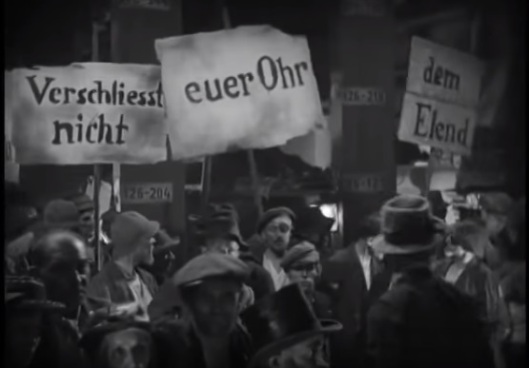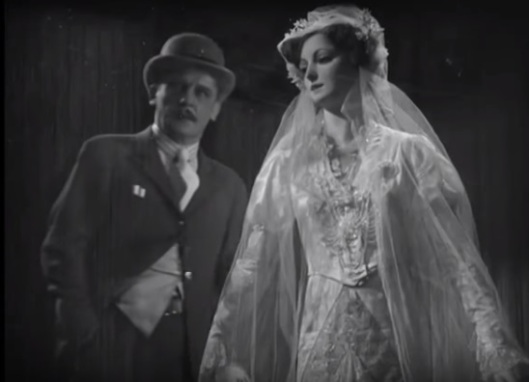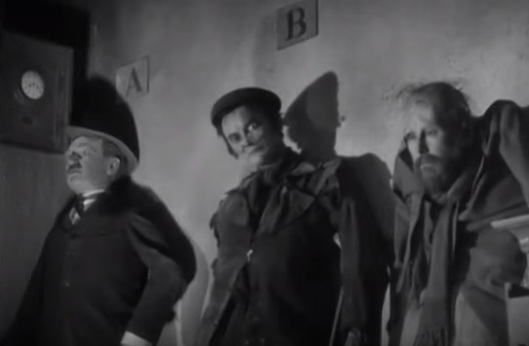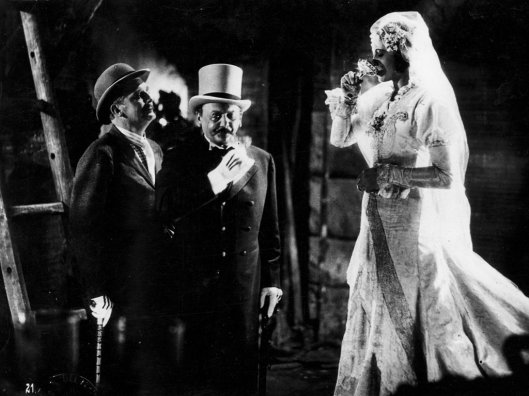Tags
Blogathon, Brecht, Classic Cinema, Comedy, Crime, Drama, Epic Theatre, Musical, Politics, Romance
Greetings dear readers, I am so happy to be a part of The Criterion Blogathon, it is truly an amazing event! The Criterion Blogathon hosts are Kristina of Speakeasy, Ruth at Silver Screenings and Aaron from Criterion Blues, all of whom are very talented writers. Follow their blogs! This wonder trio is managing posts from over a hundred participants! This blogging event celebrates many important films in international cinematic history, from the amazing Criterion Collection.
 My darlings, if you peruse the Criterion Catalog, you will see there was one film I had to cover. But we had to lobby for our titles and dame fortune smiled upon me (or rather Ruth, Aaron, and Kristina smiled upon me)!
My darlings, if you peruse the Criterion Catalog, you will see there was one film I had to cover. But we had to lobby for our titles and dame fortune smiled upon me (or rather Ruth, Aaron, and Kristina smiled upon me)!
For what other musical film combines bowler hats, weird scenic design, cynical, dark humor, hardcore “anti-damsels”, Marxist ideals, anti-establishment political messages, and Bobby Darin music? To this, we add lawsuits, suppression and near destruction by the Nazi Party?
This film’s legendary production team was lead by Austrian director G.W. Pabst. The film was based on a Bertolt Brecht play. If you follow my blog the name is familiar, if not, Brecht was a political firebrand who re-shaped 20th-century performance theory. The film features a Kurt Weill score and performances from Weill’s wife, famed chanteuse, Lotte Lenya.
So hang on my darlings as we dive into a Weimar version of the Victorian Criminal Underworld with one of my all-time favorite movie musicals, Criterion Spine #405 Die Dreigroschen-Oper better known in the English-speaking world as The Threepenny Opera!
The Plot
The Threepenny Opera tells the story of Mackie Messer a.k.a. Mack the Knife (murderer, rapist, and thief). As Mackie Messer (Rudolf Forster) wanders the dirty back streets of Victorian London, a street singer (Ernst Busch who really rocks the rolled “R” sound) recounts Mackie’s evil deeds, “Die Moritat von Mackie Messer“.
Quick Aside: Mackie is an amoral anti-hero. The Threepenny Opera openly criticizes the bourgeoisie until the criminals become capitalists. Mackie’s theme song was a huge hit best associated with Bobby Darin. Later it became a jingle for McDonald’s. Something tells me somebody at that advertising firm had a spectacular sense of humor.
If you are a child of the 80s, like me, this might ring a bell!
Back to the Film: Mackie pursues Polly Peachum (Carola Neher). After a bizarre courtship involving intense staring, Polly and Mackie get married. The chief of police and Mackie’s friend and protector, Tiger Brown (Reinhold Schunzel) visits the wedding party.
Once Polly’s father Mr. Peachum the Beggar King (Fritz Rasp) finds out about the marriage, he threatens a protest during the Queen’s coronation. Fearing violence, Brown cannot protect Mackie. Mackie is arrested.
Meanwhile, Polly takes over the criminal operation, moving the Mackie’s gang from petty thieves to the banking industry.
Mackie’s ex-girlfriend and prostitute Pirate Jenny (Lotte Lenya) (which may be the BEST character name ever) helps Mackie escape from prison, and Tiger Brown is forced resign from the police, all our major players join forces at the banks, why rob people illegally, when bankers do it every day?
A Feminist Masterpiece
Interestingly, the female characters in The Threepenny Opera are the most striking. While women in Weimar films were victims, both Polly and Jenny are extreme anti-damsels. In the song “Seeräuber Jenny” (Pirate Jenny), Jenny sings a revenge fantasy song, an anthem for disgruntled working women everywhere. Jenny is quite powerful, leading the police to Mackie and later orchestrating his escape.
Notice Lotte Lenya’s distant performance, Lenya originated the role in Brecht’s stage play. Her style is typical for Brechtian productions demonstrating “Verfremdungseffekt” or intentional distancing. This distancing prevents the audience from getting lost in the film’s “reality”.
Polly is also no shrinking violet. At her wedding to Mackie, Polly sings “Barbara Song” about the men who courted her in the past, all the men she said “No” to, “men who knew how to treat a lady”, yet the man she cannot resist, takes advantage of her and “there is no question of no”.
At first, Polly seems like a victim of Mackie Messer’s hypnotic gaze. In Mackie’s absence she controls the gang, slaps them into shape and rules with an iron fist. A shrewd businesswoman, Polly turns the small operation into a legitimate business!
A Truly Marxist Work of Art
Brecht’s secretary Elizabeth Hauptmann brought a German translation of John Gay’s 1728 play The Beggar’s Opera to Brecht. Brecht, composer Kurt Weill, Weill’s wife and singer Lotte Lenya and Hauptmann adapted the play Die Dreigroschen-Oper (The Threepenny Opera) which opened in Berlin in 1928.
There is much contention regarding the play’s actual author, although many speculate Hauptmann’s contribution was much more substantial than credited.
But the question of authorship becomes grayer when we speak of the 1931 film version.
Often when discussing cinema, we consider films within a larger body of work from a specific director or screenwriter.
Examining the film as one work within a group may increase a semiotic understanding of the material.
But this is not the case with The Threepenny Opera. It is a true collaboration being neither a truly “Brecht” nor “Pabst” work. Examining this film with an authorial lens does not define the film’s unique qualities:
Pabst, in this respect, contributed to Weimar cinema not so much a film version of a masterpiece by Brecht, nor a poem of post-romantic inwardness, psychological depth and meta-cinematic self-reflexivity, but rather, a different mode of displacing the technology of filmic production into an intensification of the erotic aspect of filmic reality, which became the heightening of the commodity aspect, the glamour, seizing not only the men or the women characters, but also the objects and the décor. Herein lies the peculiar achievement of Pabst’s mise-en-scene in The Threepenny Opera. Like other Weimar directors he was able to imbue the filmic process with value in itself, as an added attraction to the commodity stimulus of Brecht’s property become artefact, which was the opera and became the film. Pabst rendered a service to Brecht by ‘deconstructing the work, while preserving its social function within a new technical apparatus’. Adapting The Threepenny Opera into the new technical apparatus also meant inserting something into the new social apparatus- this is to say, making it as perfect as possible in the most authentic mode of social being of this apparatus – transparent duplicity (Elsaesser 326).
Both Pabst and Brecht used their art to communicate social themes. Rather than consider The Threepenny Opera as Pabst or Brecht material, it is instructive to view the film in larger terms. While there is a clear distinction between Pabst and Brecht, both artists responded to social issues plaguing Germany under the Weimar Republic. Massive unemployment combined with hyperinflation made the Reichsmark worthless, people burned paper money to stay warm, as it was cheaper than coal, both female and male prostitution was commonplace.
Berlin Stories by author Christopher Isherwood brilliantly captures the desperate and necessarily opportunistic lifestyle of the Weimar Republic. Isherwood’s stories were adapted to the 1951 play I Am a Camera, and later musicalized as Kander and Ebb’s Cabaret.
In the Weimar Republic, everything is a commodity like the slogan in Peachum’s office so brilliantly claims, “Give, and thou shalt be given.”

But the film also instructs, for the poor have “power” in their numbers. By rising as a group, they can upset the system. As Tiger Brown, Mackie and Peachum enter legitimate banking business together, Peachum now understands the way the system works, the poor support the wealthy, “because they (the poor) don’t know that we (the wealthy) need them”.
Die Neue Sachlichkeit
In Germany during the 1920s, a new artistic movement known as “die Neue Sachlichkeit” or “New Objectivity” responded to The Weimar Republic’s social ills. New Objectivity influenced art, music, theater, and cinema. New Objectivity unlike Expressionism, favored an unrelentingly coarse reality.
POLLY. Forget the romance of the past! Life begins in earnest now.
In Weimar cinema, New Objectivity is present in “street films”, melodramatic films examining social and political issues; examples include Pabst’s The Joyless Street (1925).
Brecht’s agitprop (agitation/propaganda) plays are an example of New Objectivity. Perhaps this lens is the best to examine The Threepenny Opera. Despite the British locale and source material The Threepenny Opera exemplifies Neue Sachlichkeit.
As the beggars gather to protest during the Queen’s coronation, their sign says, “Verschliesst nicht euer Ohr dem Elend” or Do not turn a deaf ear to misfortune.

This phrase aligns itself perfectly with New Objectivity. Creative works from this movement convey this message.
Everything has its price
Everything in the Weimar Republic is a commodity and corruption runs throughout society. In prison, Mackie buys better treatment from his jailor.
MACKIE. I say, Smith. You couldn’t find any heavier handcuffs? With your kind permission, I’d like a more comfortable pair.
SMITH. Well, we have them in every price range, from one guinea to ten. All depends on how much you wish to spend.
MACKIE. How much for none at all?
SMITH. Fifty.
The Threepenny Opera also deals with bodies as commodities. In addition to the literal commodity present in brothels and prostitution, the film symbolically tackles the subject with mannequins. Mannequins are present in three important scenes.
The first mannequin appears is when Mackie stalks Polly as she gazes at a wedding dress in a store window. Polly does not notice Mackie until he stands behind her. His reflection stands next to the “bride” in the window.

Later we see the mannequin stripped of her gown, Mackie’s henchmen steal the dress for Polly’s wedding. The mannequin transforms from purity to disgrace. The naked mannequin is in the storefront window, for the world to see, suggesting there is no difference between marriage and prostitution.

In both instances, a woman is purchased the only difference is the currency.
We see mannequins again at Peachum’s office, modeling the beggar uniforms.

BEGGAR. What are those?
PEACHUM.The five basic types of misery guaranteed to move the human heart and induce in a man that unnatural state in which he willingly parts with his money.
FRAU PEACHUM. Outfit C.
BEGGAR. Can’t I have Outfit A?
PEACHUM. No. That’s the young man of good family who has seen better days.
BEGGAR. But I‘ve seen better days myself.
PEACHUM. No one will believe your real suffering complain of a real stomachache and you’ll only annoy them. Enough questions just get dressed.
The exchange between Peachum and his prospective “client”, reflect the cynicism of a poor economy. As The Beggar King, Peachum runs the business of begging like an employment agency, demanding licensing fees and 50% of the take. When the beggars enter Peachum’s business, limbs straighten, eyes focus, and stumps removed. The pathetic London beggars are able-bodied men.
In the riot agitation scene, we see dismembered mannequins, as Peachum sends his beggar army to the streets. He moves his army for personal vengeance, not for justice. The army of beggars will be attacked and possibly killed. Again bodies as commodities, their value is only in their number.

PEACHUM. I have shown the rich of this world have no qualms about causing misery but can’t bear the sight of it! They have hard hearts but weak nerves. Well, we won’t spare their nerves today! By the thousands, we’ll tear at their nerves, for our rags do not conceal our wounds! Gentlemen, do not be afraid! The queen will not allow cripples to be attacked with bayonets! Forward!
Once Peachum discovers Polly is at the coronation, he recalls his army but he unwittingly set forth a destructive force that cannot be stopped, there is rioting in the streets.
Later in the film the theme of bodies as commodities continues, in “Kanonensong”, Mackie and Tiger Brown also demonstrate how bodies as the military uses human lives for their own ends, bodies are mere “steak tartare”:
Semiotic Production Design
The production design is interesting. The opening scenes feature a shipyard. A street singer sings on a stage near the yard. Later in the factory, there is a painted drop resembling the shipyard with a platform, suggesting, “everything is a set”. The production also plays with size. In the factory, we see rats amongst the barrels, normal size barrels, a little while later we see Polly and Mackie next to enormous barrels that appear three stories high. The barrels diminish the actors, as though they too were merely rats among the barrels.

Conclusion
Bertolt Brecht was unhappy with the production and he later sued the production company for compromising his artistic integrity. The court found Brecht in breach of contract and the case dropped. Brecht was contracted to write the screenplay but only provided Pabst with an outline. Interestingly, Pabst’s production is very close to Brecht’s outline, so while I am normally very pro-Brecht, it sounds like he was having an artistic tantrum by suing the production company.
There are major differences between the stage play and this adaptation, particularly the number of musical numbers omitted.
I do not think the film is untrue to the play’s spirit. I believe the film amplifies and strengthens the Marxist messages while maintaining the flavor of original material.
Viewers who would like a better sense of Kurt Weill’s phenomenal musical contribution may wish to see the 1989 film Mack the Knife which stars Raul Julia.
The repressive regime of Nazi Germany destroyed many copies of Die Dreigroschenoper, and banned Brecht and Weill works from the stage. It is a miracle that this film survived.
Be sure to visit Kristina of Speakeasy, Ruth at Silver Screenings and Aaron from Criterion Blues and check out other great entries for The Criterion Blogathon!
Day One: English Language Films Pre-1947
Day Two: Western European and Mexican Cinema
Day Three: English Language Films 1947-1980
Day Four: Asian, Russian & Middle Eastern Cinema
Day Five: English Language Films 1981 to Present
Day Six: Essays and Boxed Sets
Works Cited
Elsaesser, Thomas. Weimar Cinema and After: Germany’s Historical Imaginary. London: Routledge, 2000. Print.
“German Expressionism.” MoMA. Web. 17 Nov. 2015.
Isherwood, Christopher. The Berlin Stories. London: New Directions Publishing, 2008. Print.




I adore the film and love to sing along with my bad German accent! Well done!
LikeLiked by 1 person
Ja! Ich auch! Danke meine Liebe! 😉 These songs are spectacular, I love to sing them too! 🙂
LikeLiked by 1 person
So many random thoughts about your fab post, so I’ll just list them in no particular order…
1. The German “Mack the Knife” will be my internal soundtrack today. I’m very amused by that.
2. I think it’s awesome you included a 1980s McDonald’s commercial in a Bertolt Brecht film essay.
3. Such great analysis! Girl, you could writer Criterion Extras with work like this.
4. I love everything about this.
Thank you for joining the blogathon and bringing The Threepenny Opera to the party!
LikeLiked by 1 person
Ha-ha, that song is a brain stainer!
1.Don’t you just adore his Rs? I love this song!
2. I admit, that is the first time I heard “Mack the Knife”, imagine my delight when my mum told me it was a “Real” song. So began my love affair with Threepenny Opera and Bobby Darin.
3. You are so kind! I will gladly take the position 😉
4. Oh, thank you! Thank you! That’s a high compliment.
Thanks for hosting this event and “speeding the plow” by allowing an opportunity to write about a film which is always in the back of my mind.
-Auf Wiedersehen!
LikeLiked by 1 person
I’ve never seen this film, but it’s on my lookout list now that I’ve read this. Thanks!
LikeLiked by 1 person
It’s fab! I hope you enjoy it!
Summer
LikeLike
Awesome job! You covered a lot of great stuff here, love the extras and how you dug into the themes, influences, scenes, everything. We all smile on you some more, thanks for joining the event with this fine post.
LikeLiked by 1 person
Thanks, smiles are always appreciated! This is such a fun movie for wacky researchers (like me), because the more you watch the film, the more you find. Thanks for hosting this amazing event.
-Summer
LikeLiked by 1 person
Great post. I blasphemously prefer this film to Pandora’s Box (as a whole, yes Louise Brooks is amazing), and will have to take this off the shelf and watch soon
LikeLiked by 1 person
Oh, I do too! There is no blasphemy there, Threepenny has a better message 😉
LikeLike
Pingback: Criterion Blogathon: Day 2 Recap | Criterion Blues .....
Great post. I saw this film recently but I could never examine it in such an academic and comprehensive way as you have.
But I enjoyed Dairy and Lulu more! 🙂 :-P.
LikeLiked by 1 person
*Diary even… Doh! >.<
LikeLike
😀
LikeLike
Some films just really warrant the academic hat, I could easily write a book on this one.
Lulu & Diary of a Lost Girl, anything Louise Brooks is great. I guess you can tell I am an uber-Weimar cinema fan 😉
-Summer
LikeLike
Great review, and I’m so pleased to have found your blog via the blogathon. I’m a HUGE fan of Brecht and Weill both. I collect versions of “Pirate Jenny”—I’m obsessed with the variations in translation.
LikeLike
Hi, Kelly! Thank you, Brecht-Weill fans are great, glad to meet another!
As for “Pirate Jenny”, i too love all the variations out there. which is your favorite version?
Summer
LikeLike
I had heard about this movie, but never bothered to look for it. Now I have a goal: I’ll put this one in my “10 classics to watch in 2016”. It sounds marvelous! Could it be more wonderful than A Nous la Liberté? (If it is, I’ll have to switch the poster I have hanging in my bedroom…)
Kisses!
Le
LikeLiked by 1 person
Ooh, I have not seen A Nous la Liberté yet, but it is officially on my rental list! 🙂
Summer
LikeLike